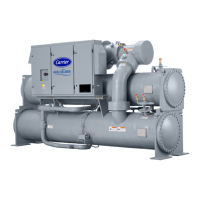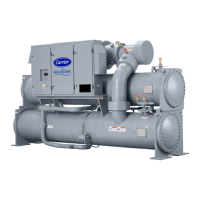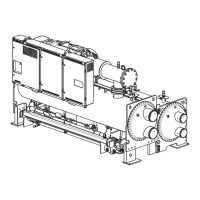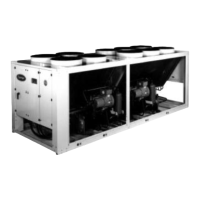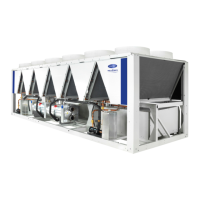26
Table 3 — CVC Display Data
1. Only 12 lines of information appear on the CVC screen at any
one time. Press the or softkey to highlight
a point or to view items below or above the current screen.
Double-click the softkey to page forward; double-click
the softkey to page back.
2. To access the information shown in Examples 9 through 21,
enter your 4-digit password after pressing the soft-
key. If no softkeys are pressed for 15 minutes, the CVC automat-
ically logs off (to prevent unrestricted access to PIC II controls)
and reverts to the default screen. If this happens, you must re-
enter your password to access the tables shown in Examples 9
through 21.
3. Terms in the Description column of these tables are listed as
they appear on the CVC screen.
4. The CVC may be configured in English or Metric (SI) units using
the CVC CONFIGURATION screen. See the Service Operation
section, page 46, for instructions on making this change.
5. The items in the Reference Point Name column
do not appear on
the CVC screen
. They are data or variable names used in CCN
or Building Supervisor (BS) software. They are listed in these
tables as a convenience to the operator if it is necessary to cross
reference CCN/BS documentation or use CCN/BS programs. For
more information, see the 23XL CCN literature.
6. Reference Point Names shown in these tables in all capital let-
ters can be read by CCN and BS software. Of these capitalized
names, those preceded by a dagger can also be changed (that
is, written to) by the CCN, BS, and the CVC. Capitalized Refer-
ence Point Names preceded by two asterisks can be changed
only from the CVC. Reference Point Names in lower case type
can be viewed by CCN or BS only by viewing the whole table.
7. Alarms and Alerts: An asterisk
in the far right field of a CVC sta-
tus screen
indicates that the chiller is in an alarm state; an excla-
mation point in the far right field of the CVC screen indicates an
alert state. The asterisk (or exclamation point) indicates that the
value on that line has exceeded (or is approaching) a limit. For
more information on alarms and alerts, see the Alarms and
Alerts section, page 19.
LEGEND
EXAMPLE 1 — CVC DEFAULT SCREEN
The following data is displayed in the CVC Default screen.
NOTE: The last three entries are used to indicate operating mode to the PIC II. These values may be forced by the CVC only.
IMPORTANT: The following notes apply to all Table 3
examples.
NEXT PREVIOUS
NEXT
PREVIOUS
SERVICE
12T
—
Motor Overload
1CR
—
Control Relay
CCN
—
Carrier Comfort Network
CHW
—
Chilled Water
CR
—
Control Relay
CT
—
Current Transformer
CVC
—
Chiller Visual Controller
ECW
—
Entering Chilled Water
HGBP
—
Hot Gas Bypass
ISM
—
Integrated Starter Module
LCW
—
Leaving Chilled Water
LRA
—
Locked Rotor Amps
mA
—
Milliamps
P
—
Pressure
SS
—
Solid State
T
—
Temperature
SV
—
Slide Valve
VFD
—
Variable Frequency Drive
WSM
—
Water System Manager
DESCRIPTION RANGE UNITS
REFERENCE POINT NAME
(ALARM HISTORY)
DISPLAY
(PRIMARY MESSAGE)
(SECONDARY MESSAGE)
(DATE AND TIME)
Compressor Ontime
0-500000.0 HOURS C_HRS
Entering Chilled Water
–40-245 DEG F ECW CHW IN
Leaving Chilled Water
–40-245 DEG F LCW CHW OUT
Evaporator Temperature
–40-245 DEG F ERT EVAP REF
Entering Condenser Water
–40-245 DEG F ECDW CDW IN
Leaving Condenser Water
–40-245 DEG F LCD WCDW OUT
Condenser Temperature
–40-245 DEG F CRT COND REF
Oil Pressure
0-420 PSI OILPD OILPRESS
Oil Sump Temp
40-245 DEG F OILT OIL TEMP
Average Line Current
0-999 % AMPS_% AMPS %
0-1 CCN
0-1 LOCAL
0-1 RESET
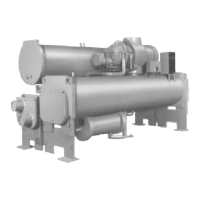
